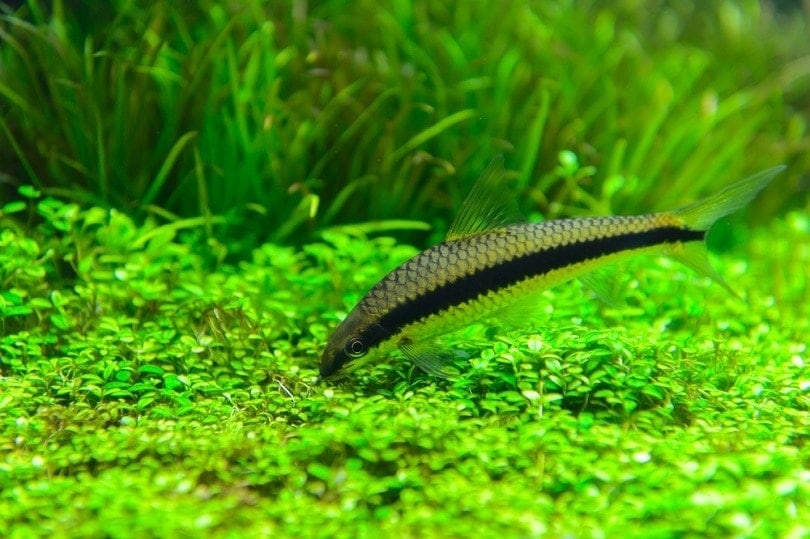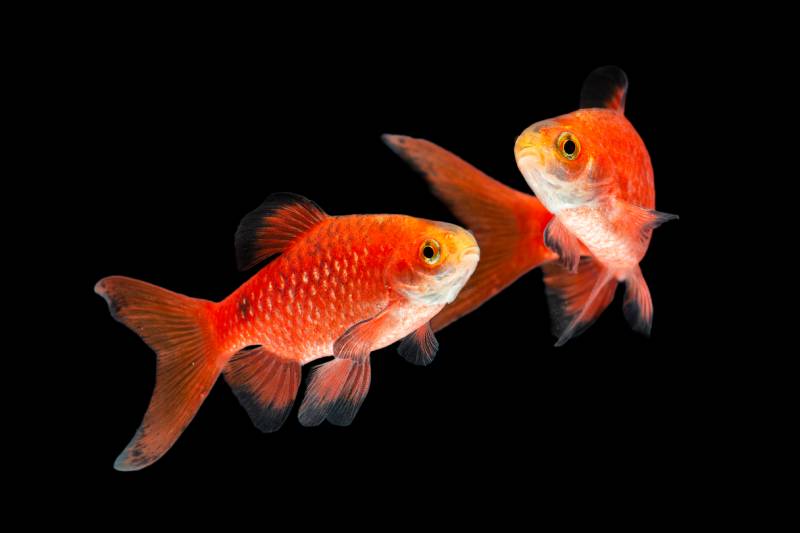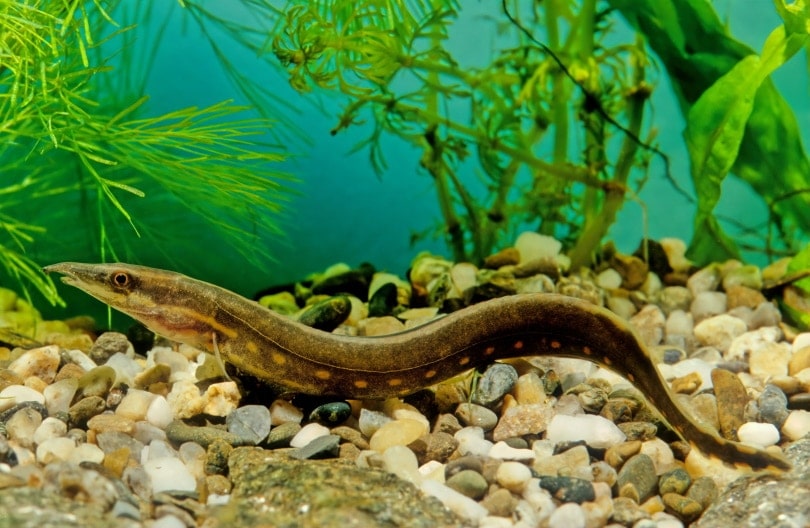17 Types of Fish From Finding Nemo (With Pictures)
By Jordyn Alger
Updated on
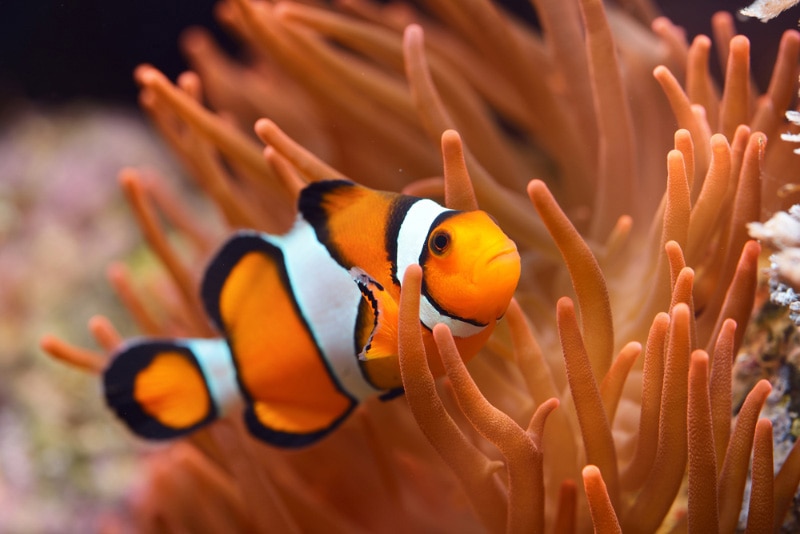
Finding Nemo is a popular animated film produced by Pixar Animation Studios at Walt Disney Pictures, featuring a lovable cast of fish characters as the main characters embark on an ocean-wide journey to save Nemo, the titular character. Many species of fish play a part in the movie, demonstrating the beautiful variety of the ocean to the viewer.
If your curiosity about these fish has evolved into something greater, this article will discuss the species in the movie. We’ll feature 17 types of fish from Finding Nemo and provide interesting facts about each.
The 17 Types of Fish From Finding Nemo
1. Clownfish

| Scientific Name: | Amphiprion ocellaris |
| Origin: | Indian Ocean, Pacific Ocean, and Red Sea |
| Size: | 4 inches or less |
One of the most prominently displayed species in the movie is the Clownfish, and Nemo and his parents are all Clownfish. This fish’s body is similar to a perch, with an ovular, elongated shape. Most of its body is orange, but it also contains large bands of white lined in with thin black stripes.
As shown in the movie, Clownfish do not like to be far from their homes, which are typically anemones within a coastal reef. They depend on their anemone for protection and are territorial of their space.
2. Blue Hippo Tang
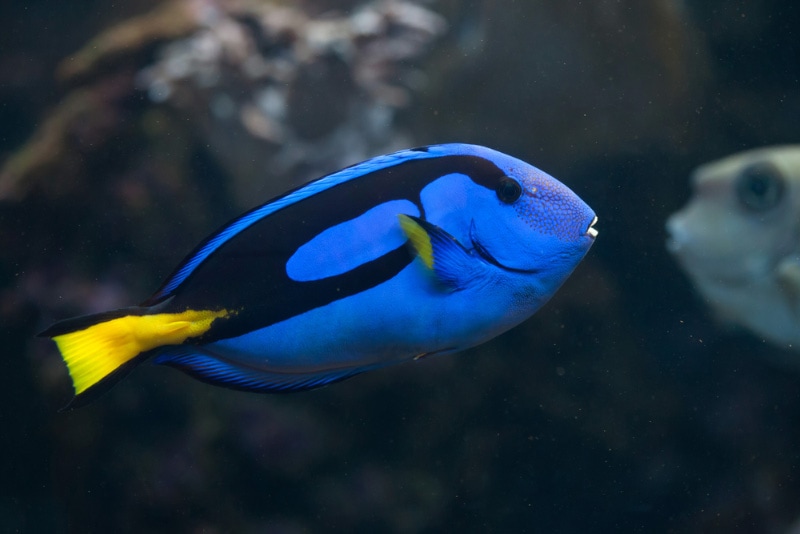
| Scientific Name: | Paracanthurus hepatus |
| Origin: | Fiji, Maldives, and Indonesia |
| Size: | 12 inches |
The Blue Hippo Tang is arguably one of the most easily recognized fish due to their resemblance to the popular character, Dory. Blue Hippo Tangs typically live in coral reefs, making homes from the small holes within the reef.
Blue Hippo Tangs are also known as Blue Tangs, Regal Rangs, Royal Blue Tangs, and Palette Surgeonfish. They are popular aquarium fish but also very sensitive, so they require highly specialized care in an aquarium setting.
3. Longnose Butterfly Fish

| Scientific Name: | Forcipiger flavissimus |
| Origin: | Indian Ocean and Pacific Ocean |
| Size: | 9 inches |
Do you remember Nemo’s young friend at the beginning of the movie? His friend’s name is Tad, and he proudly proclaims, “I’m obnoxious!” If you remember this character enough to visualize him, you may remember that he is a brightly colored fish with a long snout.
The fish is appropriately named the Longnose Butterfly Fish, but some also call them the Forceps Fish, as their snout resembles a pair of forceps. The common and hardy aquarium fish are well-liked due to their dazzling colors.
4. Spotted Eagle Ray

| Scientific Name: | Aetobatus narinari |
| Origin: | Western Pacific Ocean, Western Atlantic Ocean, and Indian Ocean |
| Size: | 16.4 feet |
Nemo’s teacher, Mr. Ray, is a Spotted Eagle Ray. The Spotted Eagle Ray is a stunning creature with a 10-foot wingspan. Considering the great size of this stingray, the Spotted Eagle Ray is clearly not meant to be kept in a home aquarium.
Spotted Eagle Rays live in the coastal regions of tropical latitudes, favoring the soft, sandy bottoms of the ocean. There, they forage for their prey. As beautiful as these creatures are, you are not recommended to go out of your way to touch them. Spotted Eagle Rays have venomous spines on their tails that they use to defend themselves against perceived threats, so it is best to keep a respectful distance from them.
5. Yellow Tang

| Scientific Name: | Zebrasoma flavescens |
| Origin: | The Pacific Ocean near Japan, Hawaii, Marianna Islands, Marcus Island, and Marshall Islands |
| Size: | 8 inches |
It’s hard to forget the quirky “Finding Nemo” character obsessed with the bubbles that the aquarium decoration would emit, especially when that character was aptly named Bubbles.
Bubbles is a Yellow Tang fish, which is a species that is commonly found in Hawaiian reefs. They come in a bright, solid yellow color that shifts to a slightly duller color at night. They have a blade-like spine and fins that help protect them from threats.
6. Striped Damselfish

| Scientific Name: | Dascyllus aruanus |
| Origin: | Western Pacific Ocean |
| Size: | 3–4 inches |
Another recognizable “Finding Nemo” character is Deb, a Striped Damselfish who believes that her reflection, whom she has named Flo, is another living being. Striped Damselfishes are ovular with wide white and dark-colored stripes. They often have a large white spot between their eyes as well as pitch-black fins.
Typically, this species lives in groups and finds shelter among branches of coral. Other names include the Whitetail Damselfish, Black and White Damselfish, and Threestripe Damselfish.
7. Royal Gramma

| Scientific Name: | Gramma loreto |
| Origin: | Western Atlantic Ocean |
| Size: | 3.1 inches |
The Royal Gramma in “Finding Nemo” is named Gurgle, and he is overly conscious about germs and filth. Another name for the Royal Gramma is the Fairy Basslet.
The Royal Gramma is a beautiful purple and gold fish with a gentle fade between colors. They like to live in groups and are commonly found in warmer climates. They live around coral reefs, often hanging upside down on the ledges. There, they feast on free-living planktonic crustaceans.
8. Puffer Fish
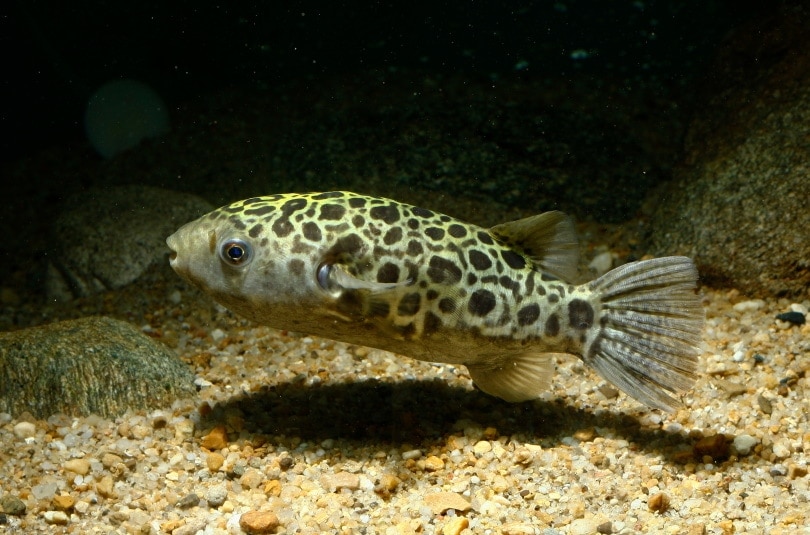
| Scientific Name: | Tetraodontidae |
| Origin: | Subtropical ocean waters |
| Size: | Varies from 2 inches to several feet |
The Puffer Fish in “Finding Nemo” is named Bloat, and he may be the species that you can identify without any help whatsoever. Puffer Fish are easily recognized by the sharp spikes that cover their bodies and their ability to inflate when threatened. Unlike many fish on this list, the Puffer Fish has a stiff body that cannot wriggle to dart through the water.
Instead, they paddle with their fins to travel. The spikes on the Puffer Fish’s body are daunting enough, but did you know that they are also venomous? Many Puffer Fish create a substance known as tetrodotoxin, which is a highly powerful toxin. Due to that, it is best to keep your hands to yourself when around this fish.
9. Moorish Idol

| Scientific Name: | Zanclus cornutus |
| Origin: | The Indo-Pacific, the Eastern Pacific Ocean, and the Red Sea |
| Size: | 7 inches |
Gill is the intimidating leader of the fish aquarium in the dentist’s office, with a distinct appearance due to his large scar. However, even if Gill didn’t have a scar, he would still make an unforgettable appearance.
Moorish Idols are a dazzling species with a unique color pattern. This pattern includes an orange spot on the upper jaw, wide yellow and black stripes on the body, and a long, white dorsal fin. Some experts believe the dorsal fin is used to make the Moorish Idol appear larger to predators, thus scaring them off.
10. Goldfish
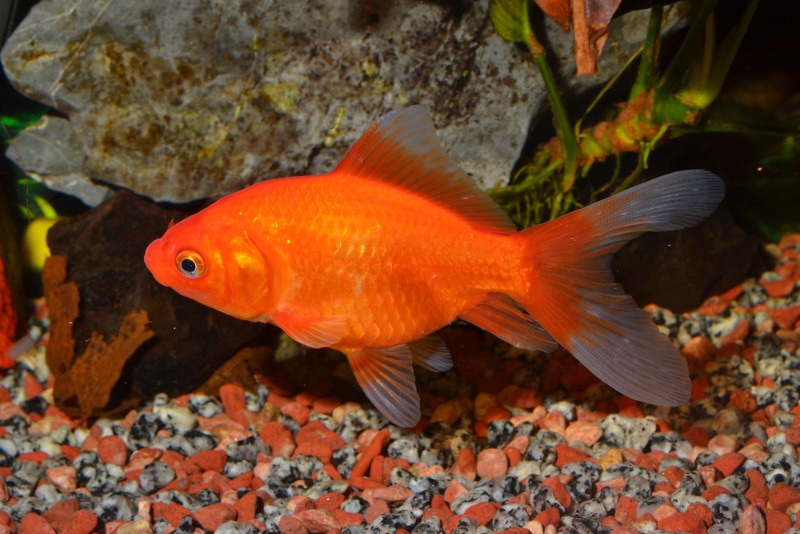
| Scientific Name: | Carassius auratus |
| Origin: | East Asia |
| Size: | 10 inches |
The Goldfish in “Finding Nemo” (named Chuckles) has a short and unfortunate role. He is the Goldfish given to Darla, the careless child who fatally shook the fish bag that held Chuckles. In the movie, he serves as a warning to Nemo regarding his potential fate if he cannot escape the aquarium and return to the ocean.
Goldfish are incredibly common in aquariums. Their color can appear orange, red, yellow, or somewhere in between. Likewise, they can grow to various sizes, from skinny and small to round and large.
11. Anglerfish

| Scientific Name: | Lophiiformes |
| Origin: | Atlantic and Antarctic Ocean |
| Size: | Up to 4 feet |
One of the movie’s most memorable and intense scenes is when an Anglerfish lures in Marlin and Dory. There are over 200 species of anglerfish, and they come in various shapes and sizes.
The reason that the Anglerfish can emit such a bright light is due to the light-producing bacteria that are contained inside the small, dangling organ. This is a feature found in female Anglerfish, and the males are typically tiny creatures with simplified bodily functions that act as parasites to the female.
12. Blue Whale

| Scientific Name: | Balaenoptera musculus |
| Origin: | Found in all oceans except the Arctic |
| Size: | 70–80 feet |
The Blue Whale is not a fish. Instead, the impressive aquatic creature is a marine mammal. Still, since a Blue Whale played such a prominent role in the movie, it seems fitting to include it in the list.
Blue Whales are the largest creatures on Earth. As large as they are, they feast on tiny prey called krill. As shown in the movie, Blue Whales inhale large amounts of water when krill are around, consuming as much as 6 tons of krill each day.
13. Great White Shark

| Scientific Name: | Carcharodon Carcharias |
| Origin: | Near coastal deposits, California, Peru, and Chile |
| Size: | 15–16 feet |
Bruce is the leader of the Fish-Friendly Sharks support group. He is a Great White Shark, which is one of the best-known predatory fish in the world. Despite the shark’s notoriety, relatively little is known about their behavior. What is known is that the Great White Shark is a powerful predator with 300 teeth, which they use to tear into their prey before eating.
The Great White Shark is considered a vulnerable species due to human activity. They play an essential role in the ocean’s ecosystem, so it is vital to protect them from extinction.
14. Shortfin Mako Shark

| Scientific Name: | Isurus oxyrinchus |
| Origin: | Argentine, the Gulf of Mexico, and Browns Bank |
| Size: | 13 feet |
The Shortfin Mako Shark makes an appearance in the movie through the character known as Chum. Chum is a Fish-Friendly Sharks support group member and has a hook in his nose due to an incident with humans.
In the real world, the Shortfin Mako Shark is found offshore in tropical climates, though it sometimes travels to cooler places. They are the fastest shark species, capable of reaching speed bursts of 46 miles per hour. As a result, some avid fishers consider the Shortfin Mako Shark a trophy catch, which contributes to their status as a vulnerable species.
15. Hammerhead Shark

| Scientific Name: | Sphyrnidae |
| Origin: | Atlantic Ocean, Pacific Ocean, Indian Ocean, and the Mediterranean Sea |
| Size: | 15–18 feet |
The Hammerhead Shark is relatively easy to identify, considering their unique, hammer-like head. This peculiar head shape allows the Hammerhead Shark to rapidly maneuver their head to the side, allowing them to snap up prey.
They can be spotted in tropical and temperate waters, ranging from the coastal regions to above the continental shelves. In the movie, there is a Hammerhead Shark named Anchor. He is yet another member of the Fish-Friendly Sharks support group.
16. Barracuda

| Scientific Name: | Sphyraena |
| Origin: | Florida and the West Indies |
| Size: | 24–39 inches |
A Barracuda only briefly makes an appearance in the film. At the beginning of the movie, there is a tragic scene in which Marlin and his wife, Coral, are attacked by a Barracuda. Coral attempts to protect their eggs, and Marlin tries to save her, but the Barracuda knocks Marlin unconscious. When Marlin wakes up, he finds himself alone with one remaining egg.
Barracudas are large, predatory fish with a fearsome attitude. They are known for their menacing appearance and sharp teeth, which are shown in the movie.
17. Flounder

| Scientific Name: | Paralichthys |
| Origin: | Gulf of Mexico |
| Size: | 9–24 inches |
Near the beginning of the movie, there is a short scene where Nemo’s young friends mess with an older fish named Mr. Johannsen. He is a fish that lays flat on the ground with his eyes on one side of his body. Based on this description, it is evident that Mr. Johannsen is a Flounder.
Interestingly, Flounders are not initially born with two eyes on one side of their body. Instead, they have one eye on each side before they eventually lean to one side. After a while, the opposite eye shifts toward the dominant side, and the Flounder has two eyes on one side of their body.
Conclusion
There are plenty of fish in the sea, and the movie “Finding Nemo” succeeded in exhibiting some incredible species. While not all of the fish on this list are appropriate for a home aquarium, many can be purchased and properly cared for by fish enthusiasts. If you are eager to make your newest aquarium look like the cast of “Finding Nemo,” reach out to your local pet stores to determine if any of these species are available to bring home.
Featured Image Credit: Aastels, Shutterstock

